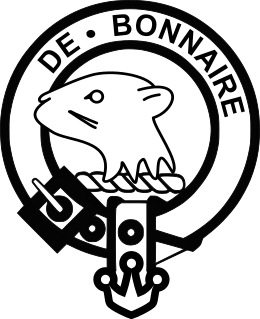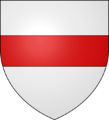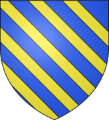Clan Bethune facts for kids
Quick facts for kids Bethune of Balfour |
|
|---|---|

Crest: An otter’s head erased argent.
|
|
| Motto | Debonnaire (Of good lineage) |
| Profile | |
| Region | Lowlands |
| District | Fife and Angus |
 |
|
| Bethune of Balfour has no chief, and is an armigerous clan | |
| Historic seat | Balfour in Markinch, Fife |
The Clan Bethune is a Scottish family. They are known for using the last name Bethune. This family comes from the landowners of Balfour in Fife, Scotland. Balfour is an estate in the Scottish Lowlands near Markinch.
The family name comes from the town of Béthune. This town was in a place called Flanders (now part of France) before the year 1000. Over time, how the name was said changed. It went from the French bay-tune to the Scots bee-t'n. This was often written as Beaton. Around 1560, family members started using the French spelling Bethune again.
It is important to know that Bethune families from the Scottish Highlands and Scottish Islands are different. They are not connected to the Bethunes of Balfour.
| Top - 0-9 A B C D E F G H I J K L M N O P Q R S T U V W X Y Z |
Where Did the Bethune Family Start?
Before the year 1000, towns in Flanders had castles. These castles and towns were ruled by families who passed down their power. One such family was the lords of Béthune. This town was in a region called Artois. The first known lord was Robert I de Béthune. He lived from about 960 to 1037.
Robert I ruled the town and castle of Béthune. He also started the church of Saint-Barthélémy there. He owned old family lands outside the town. He was also the protector of the Abbey of Saint-Vaast in Arras. The main part of the family stayed in Béthune until 1246. Then, the heiress Maud married Guy, Count of Flanders. Other parts of the family moved to other places. They started families in France, Palestine, Cyprus, England, and Scotland.
Early Bethunes in Scotland
Some historians say Bethune family members were in Scotland before 1093. But the first real proof comes much later. Around 1192, a document from Lindores Abbey mentions Robert de Bethune. This was likely Robert VI from the Artois family.
Before 1210, a record from Arbroath Abbey lists a church leader named John de Bethune. Around 1220, Robert de Bethune is mentioned with St Andrews Cathedral Priory. Sir David de Bethune, a knight, appears in another Arbroath document.
From then on, many church leaders and knights named Bethune appear in Scottish records. They were mainly in Angus and Fife. It is hard to connect all these early people into one family tree.
The first clear family link starts with Sir Alexander de Bethune. He was a knight. In 1314, he was part of the Scottish Parliament. This meeting was held at Cambuskenneth. In 1332, he died fighting for Robert the Bruce's supporters. This was against the Balliol rebels at Dupplin Moor.
People believe he was the father of Robert Bethune. Around 1345, Robert married Janet. She was the heiress of Balfour. Their home was Balfour Castle. It was next to the River Leven. This was just south of Milton of Balgonie.
Some say the Bethunes of Balfour started differently. At the funeral of Archbishop James Bethune in 1603, a story was told. It said their family came from a French Bethune. This person came to Scotland around 1449. He married the heiress of Balfour. His name was Jacques de Béthune. His father, Jean, died at the Battle of Agincourt in 1415. But there are no Scottish records to prove this story.
The Bethunes of Balfour Family Line
The castle and lands of Balfour were passed down through the male family line. This started with Robert Bethune and Janet Balfour's marriage. The last male owner was James Bethune, 15th of Balfour. He died in France in 1719. He was a Jacobite rebel and had to leave Scotland.
Later, the Balfour estate passed through female family members. In 1836, Eleanor Bethune inherited it. Her husband, John Drinkwater, changed his last name to Bethune. Their grandson sold Balfour in 1888. The old Balfour House has since been taken down.
Other Bethune Families from Balfour
Over 500 years, the Bethune family held Balfour. During this time, several smaller family branches started. Some of these branches still exist today.
Bethune of Creich
This branch came from David Bethune, 1st of Creich. He died in 1505. He was the Treasurer of Scotland. He was the son of John Bethune, 5th of Balfour. This male family line ended with William Bethune, 9th of Creich, who died in 1670.
Bethune of Balfarg
This branch came from James Bethune, 1st of Balfarg. He died in 1546. He was the son of John Bethune, 6th of Balfour. This line ended with his sons. They were James Bethune, Archbishop of Glasgow, Andrew Bethune, and John Bethune. The latter two worked for Mary, Queen of Scots.
Bethune of Melgund
This branch came from Cardinal David Bethune. He died in 1549. He had several children. Many of their descendants are still alive today. This includes Queen Elizabeth II of the United Kingdom.
Bethune of Sweden
This family claims to be related to James Bethune, 6th of Creich, who died in 1618.
Bethune of Langhermiston
This branch started with Alexander Bethune, 1st of Langhermiston. He died after 1641. He was the son of Robert Bethune, 10th of Balfour. This line ended with his son, Alexander Bethune, 2nd of Langhermiston, who died in 1672.
Bethune of Blebo
This branch began with Andrew Bethune, 1st of Blebo. He died in 1653. He was the son of David Bethune, 11th of Balfour. This line ended with Margaret Bethune. Her family led to the later Bethune baronets. This title ended in 1997 when Sir Alexander Bethune, 10th Baronet died.
Bethune of Bandon
This branch started with Robert Bethune, 1st of Bandon. He died in 1660. He was the son of David Bethune, 11th of Balfour. This line ended with Ann Bethune, who died in 1785 without children.
Bethune of Craigfoodie, Rowfant, and Denne
This branch came from William Bethune, 1st of Craigfoodie. He died in 1699. He was the grandson of David Bethune, 11th of Balfour. His oldest son, John Bethune, 2nd of Craigfoodie, moved to England. His male family line continues today.
Bethune of Massachusetts
- George I (died 1735) was a younger son of William, 1st of Craigfoodie. He moved to Massachusetts in America. In 1713, he married Mary Waters in Boston. They had ten children. Two of his children have descendants living today.
- Jane (1714–1795) was George I's daughter. Her first marriage was to Moses Prince. They had a daughter named Jane (1740–1800). This Jane later married Chandler Robbins.
- George II (1720–1785) was the only son of George I to have children. In 1754, he married Mary Faneuil (1732–1797). She was the niece of Peter Faneuil.
- George III (1769–1859) was the only son of George II to have sons. His two sons, George IV (1813–1886) and John (1817–1873), did not marry.
Patton-Bethune
This branch came from James Bethune, 4th of Blebo, who died in 1709.
Lindesay-Bethune
This branch came from Catherine Bethune, who died in 1730. She was the granddaughter of David Bethune, 11th of Balfour. Today, this line is represented by James Lindesay-Bethune, 16th Earl of Lindsay.
Bethune Family Coats of Arms
The first coat of arms for the lords of Béthune was simple. It was a silver shield with a red horizontal band. This represented the town they ruled.
When they became protectors of the Abbey of Saint-Vaast, they changed their arms. They used gold diagonal bands on a blue background. This showed their higher status.
Around 1190, Guillaume II, lord of Béthune, married Matilda of Dendermonde. She was an heiress. At her request, their oldest son changed his arms. He used the arms of her Dendermonde family. These arms were the same as the old Béthune arms: a silver shield with a red horizontal band.
When Bethune knights in Scotland started using seals, they used the same horizontal band. Sir David de Bethune in 1286 and Sir Andrew de Bethune in 1292 are examples.
Through marriage with the Balfour heiress, the Scottish family changed their arms. They used a blue shield with a gold horizontal band. This band had three gold diamond shapes (called mascles). This shield was then combined with the Balfour arms. This was the coat of arms for the Bethunes of Balfour from about 1350 to 1672.
In 1672, a new law said all Scottish arms had to be registered. If not, they would be lost. The Lord Lyon, who manages Scottish heraldry, changed the old Bethune shield slightly. It became a blue shield with a gold horizontal band and three gold lozenges (another diamond shape).
However, in 1837, Eleanor Bethune of Balfour registered her arms. The Lord Lyon changed them back to the original design. It was a blue shield with a gold horizontal band and three gold mascles. Her descendants have not registered the arms since then.
Smaller branches of the Fife Bethunes used the family arms with small changes. Three sets were registered in 1672: Bethune of Bandon, Bethune of Blebo, and Bethune of Langhermiston. The Langhermiston male line ended soon after. The Blebo arms went to the Bethune Baronets, whose male line also ended. The Bandon arms went to the Bethunes of Craigfoodie, Rowfant, and Denne. Their male line continues, but they have not registered their arms.
Bethunes of the Highlands and Islands
In 1778, a book by Reverend Thomas Whyte claimed something. He said many families in the Scottish Highlands and Islands named Bethune or Beaton came from a Peter Bethune. He said this Peter was from the Bethunes of Balfour.
But no one has found proof for this connection. It is likely that this claim was mistaken. Many people in his book were part of the Beaton medical kindred. This was a different Scottish family. They are often confused with the Bethunes of Balfour because of the similar name.
See also
- Beaton medical kindred, a different family with a similar name.
- House of Bethune, an article about related families in France.
Images for kids







